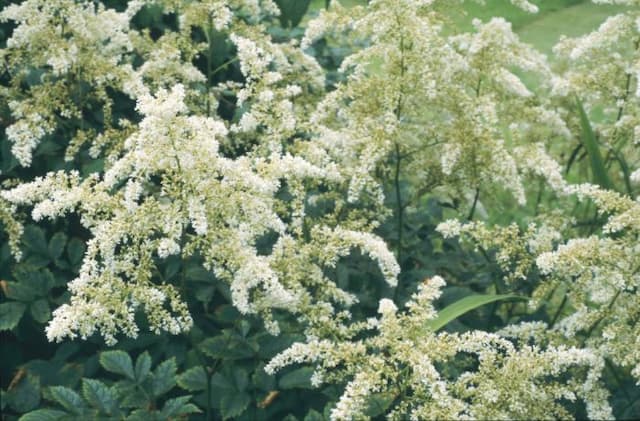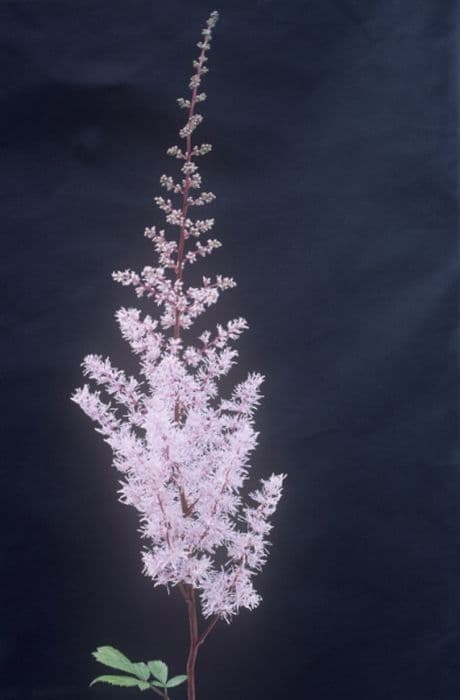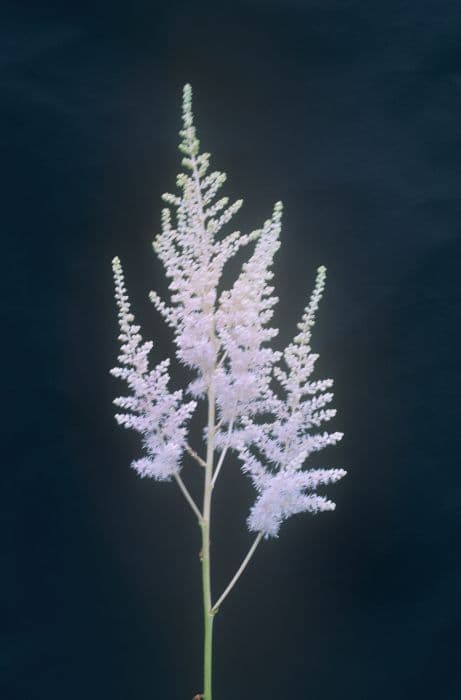Fall-Blooming Bergenia Bergenia 'Herbstblute'

ABOUT
Bergenia 'Herbstblute', commonly known as Fall Blooms or Autumn Bergenia, is an attractive perennial that features a distinct look, notable for its seasonal color transformation. The foliage is known for its bold, leathery leaves which are typically a shiny green color. During the colder months, the leaves often change to a rich reddish-bronze, adding a warm splash of color to the garden landscape. The blooms of the Autumn Bergenia stand out with their bright and showy flowers. These blossoms are usually seen in striking shades of pink, that can range from a soft pastel to a vivid magenta, forming eye-catching clusters on sturdy stems that rise above the foliage. The flowers provide a delightful contrast to the leaves, brightening gardens in the blooming season. Adding to its visual appeal, the leaves are generally quite large and have a rounded, somewhat heart-shaped silhouette with a wavy or serrated edge, which creates an interesting texture. The plant grows in a clump-forming habit, spreading out its rich foliage and creating a dense mat that can serve as an elegant ground cover. Overall, Bergenia 'Herbstblute' is cherished for its robust nature, its striking seasonal leaf coloration, and its vibrant floral display that breathes life into a garden, especially during the transition from summer to autumn.
About this plant
 Names
NamesFamily
Saxifragaceae
Synonyms
Fall-Blooming Bergenia, Autumn Bergenia, Herbstblute Saxifrage
Common names
Bergenia 'Herbstblute'
 Toxicity
ToxicityTo humans
The Bergenia, commonly known as 'Elephant's Ears', is not considered highly toxic to humans. However, ingestion of any part of the plant may lead to mild stomach upset or discomfort, as it is not meant for consumption.
To pets
Similarly, for pets, Elephant's Ears are not highly toxic. If a pet ingests parts of the plant, they might experience mild gastrointestinal upset such as vomiting or diarrhea. Close monitoring is advised if ingestion occurs, and consult a veterinarian if symptoms persist or worsen.
 Characteristics
CharacteristicsLife cycle
Perennials
Foliage type
Evergreen
Color of leaves
Varies
Flower color
Pink
Height
1-2 feet (30-60 cm)
Spread
1-2 feet (30-60 cm)
Plant type
Herb
Hardiness zones
3
Native area
Asia
Benefits
 General Benefits
General Benefits- Attractive Foliage: Bergenia 'Herbstblute', commonly known as the Saxifrage 'Herbstblute', has glossy, leathery leaves that add texture to garden spaces.
- Seasonal Interest: It offers seasonal interest with leaves changing color throughout the year, often turning bronze or red in fall and winter.
- Drought Tolerance: Once established, it is quite drought-tolerant, making it suitable for gardens with lower water availability.
- Shade Tolerant: This plant can thrive in partially shaded conditions where other plants might not do as well.
- Low Maintenance: Bergenia 'Herbstblute' requires minimal care once established, making it an ideal choice for gardeners of all levels.
- Long Blooming: It produces flowers in the spring, which can last for several weeks, providing extended visual interest.
- Ground Cover: With its spreading habit, it can be used as an effective ground cover to suppress weeds and cover bare spots.
- Frost Hardy: The plant is capable of withstanding cold temperatures, making it suitable for gardens in cooler climates.
- Attracts Pollinators: The flowers can attract bees and other pollinators, supporting local ecosystems.
- Deer and Rabbit Resistant: Bergenia 'Herbstblute' is not a favorite of deer and rabbits, reducing the likelihood of damage from these animals.
 Medical Properties
Medical Properties- This plant is not used for medical purposes.
 Air-purifying Qualities
Air-purifying QualitiesThis plant is not specifically known for air purifying qualities.
 Other Uses
Other Uses- As a natural dye: Bergenia leaves can produce dyes in shades of green and brown, suitable for coloring fabrics and yarns.
- Dry floral arrangements: The plant’s leathery leaves can hold their shape and color, making them ideal for use in dry floral decorations.
- Garden border definition: With its clumping nature, Bergenia is used to define the edges of garden beds and pathways.
- Fairy gardens: Due to their low-growth habit and attractive foliage, Bergenia can be incorporated into whimsical fairy garden designs.
- Ground cover: Bergenia can cover bare spots in the garden, reducing weed growth and soil erosion.
- Winter interest: Since Bergenia leaves often change color and persist through mild winters, they can be used to add interest to the garden during the colder months.
- Tannin source: Bergenia leaves contain tannins and have been used traditionally in tanning leather.
- Photography: The bold leaves and flowers of Bergenia make it a popular subject for botanical photography, especially in spring when in bloom.
- Art and crafts: The plant's leaves can be used to make leaf impressions in clay or cement for decorative stepping stones or garden art.
- Culinary decoration: Although not commonly used for eating, the flowers of Bergenia can be used as a decorative garnish on plates and platters for special occasions.
Interesting Facts
 Feng Shui
Feng ShuiThe Bergenia is not used in Feng Shui practice.
 Zodiac Sign Compitability
Zodiac Sign CompitabilityThe Bergenia is not used in astrology practice.
 Plant Symbolism
Plant Symbolism- Hardiness: Bergenia is known for its hardy nature, being able to survive in tough climate conditions, which is why it symbolizes toughness and resilience.
- Endurance: 'Herbstblute,' which translates to 'Autumn blossom,' reflects the plant's ability to thrive and bloom as the temperatures drop, representing endurance through change.
- Tenacity: The robust growth habit of Bergenia where it forms dense clumps that persist year after year can be seen as a sign of tenacity and determination.
- Adaptability: As Bergenia can adjust to various light and soil conditions, it is symbolic of adaptability and the ability to thrive in diverse environments.
- Protection: Given its large leaves that often were used to cover up and protect smaller plants, Bergenia symbolizes shelter and protection.
 Water
WaterThe common name for Bergenia 'Herbstblute' is Heartleaf Bergenia. To water this plant, it's best to keep the soil evenly moist but not soggy. During the growing season in spring and summer, water Heartleaf Bergenia once a week with about 1 gallon of water per plant. In the fall and winter, reduce watering to every other week, ensuring that the soil doesn't dry out completely. Always check the top inch of soil for dryness before watering again.
 Light
LightHeartleaf Bergenia thrives in conditions where it can receive partial shade to full sun. It is adaptable but prefers a spot that offers morning sunlight and afternoon shade. This ensures that the plant is protected from the intense heat of the midday sun, which can be especially important in hotter climates.
 Temperature
TemperatureHeartleaf Bergenia is a hardy plant that can withstand temperatures as low as 0 degrees Fahrenheit and can tolerate up to around 75 degrees Fahrenheit. The ideal temperature range for this plant is between 60 to 70 degrees Fahrenheit. It can survive short periods of colder snaps and summer heat, but prolonged exposure to temperatures outside of its comfort zone may stress the plant.
 Pruning
PruningPruning Heartleaf Bergenia is primarily done to remove spent flower stalks and to tidy up any damaged or brown leaves. The best time for pruning is in late winter or early spring before new growth begins. Annual pruning is sufficient for keeping Heartleaf Bergenia healthy and looking its best, and it can also encourage more prolific blooming.
 Cleaning
CleaningAs needed
 Soil
SoilBergenia, commonly known as 'Pigsqueak', thrives best in a well-draining soil mix with a pH of 5.5 to 7.5. An ideal soil mix can be created using two parts garden loam, one part peat, and one part perlite or coarse sand to ensure proper drainage and aeration. Adding organic matter such as compost will also enrich the soil and benefit plant growth.
 Repotting
RepottingPigsqueak, or Bergenia 'Herbstblute', does not require frequent repotting and can be done every 2-3 years. It's best to repot only when the plant has outgrown its current container or the soil becomes compacted. Spring is the ideal time for repotting to allow the plant to establish before the growing season.
 Humidity & Misting
Humidity & MistingPigsqueak prefers average room humidity levels and does not require special humidity conditions. While it can adapt to various environments, avoiding excessively dry air conditions can help maintain its foliage's health and prevent leaf tip browning.
 Suitable locations
Suitable locationsIndoor
Place Pigsqueak in bright, indirect light indoors.
Outdoor
Plant Pigsqueak in partial shade with well-draining soil.
Hardiness zone
3-8 USDA
 Life cycle
Life cycleThe life of Bergenia 'Herbstblute', commonly known as Autumn Bergenia or Fall Blooming Bergenia, begins with seed germination, which occurs in moist soil conditions often during spring. Once the seedling emerges, it develops into a rosette of large, leathery leaves which persist as evergreen foliage throughout the year in mild climates. The plant reaches maturity in a couple of years, at which point it develops stout stems that hold clusters of bell-shaped flowers ranging from pink to red, blooming primarily in fall, hence its name. After pollination, often by insects, the flowers produce capsules filled with tiny seeds that are dispersed by wind or wildlife to propagate new plants. Autumn Bergenia is also capable of vegetative reproduction through its rhizomes, forming clumps that can be divided and transplanted to encourage spread or manage its size. The plant has a perennial cycle, with foliage dying back in harsh winters, but it rebounds in the spring from the rhizomes, thus continuing its lifecycle.
 Propogation
PropogationPropogation time
Late summer
Propogation: The Bergenia 'Herbstblute', commonly known as Fall-blooming Bergenia, propagates most effectively by division, generally after the blooming period in the fall or in early spring. This involves gently digging up the clump of the plant and using a sharp, clean spade or knife to split the root ball into smaller sections, making sure each section has at least one growth bud or shoot. These sections can then be replanted in moist, well-draining soil, spacing them about 12 inches (approximately 30 centimeters) apart to allow sufficient room for growth. It's important to water the new divisions regularly until they are established and showing signs of new growth. This method is favored as it maintains the characteristics of the parent plant and allows for quick establishment in the garden.









